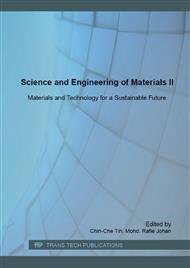[1]
L, Yonghong, J. Renjie, L. Qingyun, Y. Lili, L. Xiaopeng, Electric discharge milling of silicon carbide ceramic with high electrical resistivity, Internat. J. of Machine Tools and Manuf. 48. no. 12 (2008) 1504-1508.
DOI: 10.1016/j.ijmachtools.2008.03.012
Google Scholar
[2]
J. Yan, Z. Zhang, T. Kuriyagawa, Mechanism for material removal in diamond turning of reaction-bonded silicon carbide, Internat. J. of Machine Tools and Manuf. 49 (2009) 366–374.
DOI: 10.1016/j.ijmachtools.2008.12.007
Google Scholar
[3]
S. Lopez-Esteban, C. F. Gutierrez-Gonzalez, G. Mata-Osoro, C. Pecharroman, L.A. Diaz, R. Torrecillas, J.S. Moya, Electrical discharge machining of ceramic, semiconductor, metal nanocomposites, Scripta Materialia. 63(2) (2010) 219-222.
DOI: 10.1016/j.scriptamat.2010.03.062
Google Scholar
[4]
I. Puertas, C.J. Luis, A study on the electrical discharge machining of conductive ceramics, J. of Mater. Processing Tech. 153/154, (2004) 1033–1038.
DOI: 10.1016/j.jmatprotec.2004.04.197
Google Scholar
[5]
Q.Y. Ming, L.Y. He, Powder-suspension dielectric fluid for EDM, J. of Mater. Processing Technol. 52 (1995) 44–54.
DOI: 10.1016/0924-0136(94)01442-4
Google Scholar
[6]
P. Pecas, E. Henriques, Influence of silicon powder-mixed dielectric on conventional EDM, Internat. J. of Machine Tools and Manuf. 43(14) (2003) 1465-1471.
DOI: 10.1016/s0890-6955(03)00169-x
Google Scholar
[7]
H.M. Chow, B.H. Yan, F.Y. Huang, J.C. Hung, Study of added powder in kerosene for the micro-slit machining of titanium alloy using electro-discharge machining, J. of Mater. Processing Technol. 101(1) (2000) 95-103.
DOI: 10.1016/s0924-0136(99)00458-6
Google Scholar
[8]
P. J Liew, J. Yan, T. Kuriyagawa, Carbon nanofiber assisted micro electro discharge machining of reaction-bonded silicon carbide, J. of Mater. Processing Techn. 213(7) (2013) 1076-1087.
DOI: 10.1016/j.jmatprotec.2013.02.004
Google Scholar
[9]
K.L. Wu, B.H. Yan, J.W. Lee, C.G. Ding, Study on the characteristics of EDM using dielectric with surfactant, J. Mater. Process. Technol. 209 (2009) 3783-3789.
Google Scholar
[10]
M. Kolli, A. Kumar, Effect of dielectric fluid with surfactant and graphite powder on Electrical Discharge Machining of titanium alloy using Taguchi method, Engr. Sci. and Technol., an Internat. J. (2015) 1-12.
DOI: 10.1016/j.jestch.2015.03.009
Google Scholar
[11]
K. Y. Leong, N. Mohd Hanafi, R. Mohd Sohaimi, N. H. Amer, The effect of surfactant on stability and thermal conductivity of carbon nanotube based nanofluids, Thermal Sci. (2014) 77-78.
DOI: 10.2298/tsci130914078l
Google Scholar
[12]
A.S. Dukhin, P.J. Goetz, Ionic Properties of So-called Nonionic Surfactants in Nonpolar Liquids, Dispersion Technol. Inc. New York. (2004) 1–21.
Google Scholar
[13]
J.Q. Feng, D.A. Hays, Relative importance of electrostatic forces on powder particles, Powder Tech. 135–136 (2003) 65–75.
DOI: 10.1016/j.powtec.2003.08.005
Google Scholar
[14]
H.K. Kansal, Sehijpal Singh, Pradeep Kumar, Technology and research developments in (PMEDM), J. of Mater. Processing Technol. 184 (2007) 32–41.
Google Scholar
[15]
M.J. Rosen, Surfactants and Interfacial Phenomena, third ed. Wiley Interscience, New York (2004) 311-324.
Google Scholar


